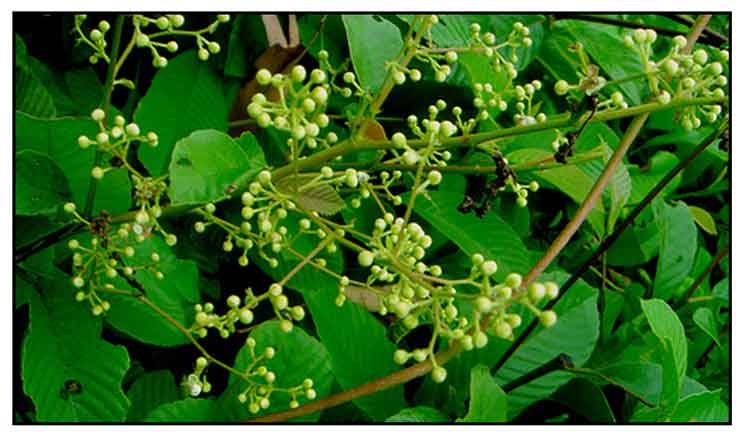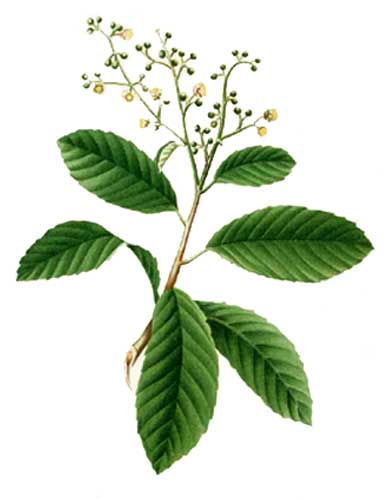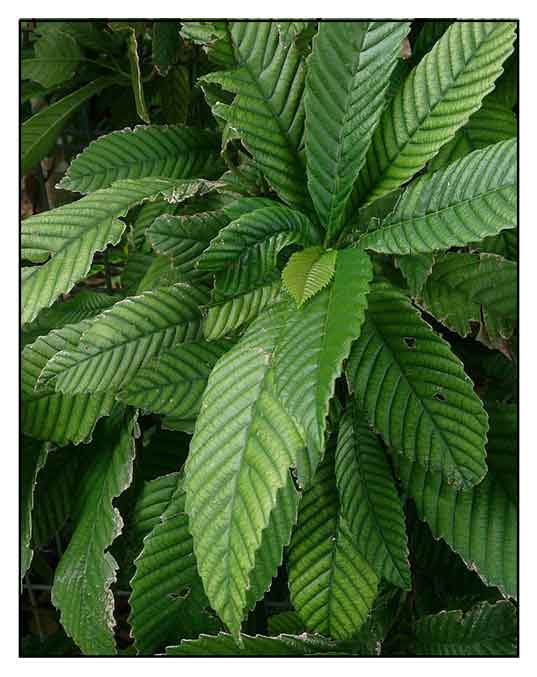
Gen info
- Diilleniaceae is a family of flowering plants with 11 genera and about 430 known species. Most of the members are woody plants - lianas or trees such as Dillenia. (20)
- Tetracera is a genus of flowering plants of the family Dilleniaceae native to the tropics. Several species are lianas. (21)
 Botany Botany
• Malakatmon is a climbing vine growing about 3 to 4 meters in length. Leaves are leathery, harsh, oblong-ovate to oblong-elliptic, 6 to 12 centimeters long, toothed at the margins. Flowers are numerous, white, about 8 millimeters in diameter, and borne on terminal and axillary panicles, 10 to 25 centimeters long. Carpel is solitary. Fruit is oblong-ovoid, pointed, nearly 1 centimeter long, containing one hairy seed. Aril is cupular and toothed.
• Growth form: A large evergreen woody climber with a twining growth habit, it can be grown as a shrub. The stems can reach up to 30m in length or 2m in height as a shrub. Foliage: Simple ovate leaves are arranged in opposite pairs along the stem, the new foliage being reddish-pink before turning green as it matures. The leaf is scabrid (rough to the touch) with an acute leaf apex, a serrated leaf margin and penninerved leaf venation. Flowers: The small white flowers are borne on terminal panicles.Â
Distribution
 - Native to the Philippines. - Native to the Philippines.
-
Common in dry thickets, at low and medium altitudes in Pangasinan, Zambales, Tarlac, Bataan, Rizal, Cavite, and Laguna Provinces in Luzon; and in Mindoro, Busuanga, Palawan, Biliran, and Mindanao.
- Also native to Bangladesh, Borneo, Cambodia, Jawa, Laos, Lesser Sunda Is., Malaya, Myanmar, Nicobar Is., Philippines, Sulawesi, Sumatera, Thailand, Vietnam (19)
Constituents
- Study of methanol leaf extract yielded yielded three terpenoids (stigmasterol, betulinic acid and an isomeric mixture of sitosterol glycoside and stigmasterol glycoside) and six flavonoids, viz., kaempferol, quercetin, isoscutellarein, hypoletin, astragalin and kaempferol-3-O-(6"-O-p-trans-coumaryl) glucoside. (see study below) (7)
- Stem idioblast cells secrete alkaloids, terpenoids, and phenols; trichomes yielded flavonoids. (see study below) (15)
- Study of ethanol extract of leaves yielded six known flavonoid compounds:
quercetin-3-O-L-rhamnoside (1), genistein (2), quercetin (3), quercetin 3-O-ß-D-glucuronide (4), kaempferol (5) and quercetin-3-O-a--arabinofuranoside (6). (17)
Properties
- Studies have suggested anti-gout, xanthine oxidase inhibitory, anti-viral, anti-diabetic, hepatoprotective, antibacterial, anti-quorum sensing, protein phosphatase 1B inhibitory properties.
Parts used
Leaves, bark, roots, stem.
 Uses Uses
Edibility
- No reports found on use for food consumption.
Folkloric
- Wood was one of the best known and most popular drugs of the Binondo marketplace; used as an infusion internally for hemoptysis of consumptives, and externally in the treatment of sore throat. Its action was attributed to the large amount of tannins it contains.
- Used for treatment of rheumatism, inflammation, hepatitis, sore throat, gout and diabetes.
- In Malaysia, used after childbirth; also used for dysentery, diarrhea, burns, and coughs. (6) Stem decoction taken orally for weakness due to fever or influenza. (14)
- Roots used in burn mixtures and for treatment of diarrhea. Stem sap used as antitussive, and stem infusion sued as gargle for treatment of oral candidiasis. (24)
- Lao people use roots, fresh and chewed or as decoction, for post-partum recovery or post-partum secondary hemorrhage, and for infant oral candidiasis; also as aperative. (9)
- In Vietnam, stem and leaves used for treatment of osteoarthritis and back pain. (10) Roots and stems used to treat hepatitis, gout, and swelling. (15)
- In Malaysia stem decoction taken orally for weakness due to fever or influenza. (11)
- In Indonesia, the Anak Dalam tribe of Jambi Province, use stems for the treatment of diarrhea. (15) Poultice of finely crushed young shoots use to treat snake bites. (22)
- Juice of ground roots applied to mouth ulcers. Stem infusion drunk for treatment of hemoptysis in tuberculosis. (16)
- In Myanmar, traditional practiitioners in Da Lat and Nha Trang-Tuy Hoa use roots and stems for treatment of hepatitis. (29)
Others
- Polish: Long ago, in Kuala Lumpur, Malaysia, the finely abrasive leaf was used to polish pewter. (•) Leaves used as sandpaper for smoothing wood. (16)
- Tying: Heated and twisted stems used as durable bindings for fish traps. (22)
Studies
• Anti-Hyperglycemic / Leaves:
Study on the crude aqueous and methanol extracts of the leaves of T. scandens, showed antidiabetic efficacy. There was significant reduction of fasting glucose in treated diabetic rats. The highest anti-hyperglycemic effect (62.5%) was exhibited by the aqueous extract at 0.25 g/kbw; the methanol extract showed 36.5% effect at 0.5 g/kbw. The antidiabetic effect was comparable to glibenclamide. (1)
• Xanthine Oxidase Inhibition / Gout:
In a study of 288 extracts from 96 medicinal plants, the methanol extract of Tetracera scandens was among those that exhibited XO inhibitory activity. (2) In a study of Vietnamese herbs for xanthine oxidase inhibition in patients with chronic hyperuricemia and gout, Tetracera scandens showed great potential for therapeutic effect. (8)
• Increased Glucose Uptake / Genistein Derivatives:
Study isolated five isoflavones of previously known structures: genistein, 3',5'-diprehylgenistein, 6,8-diprenylgenistein, derrone and alpinumisoflavone. Compounds 2 to 5 showed significant glucose-uptake activity. Results concluded that T scandens and its constituents exhibited highly desirable activities on T2 diabetes with significantly stimulated uptake of glucose in L6 myotubules. (3)
• Anti-HIV activity / Anti-Reverse Transcriptase Activity: Study showed an ethanol extract of T. scandens to have anti-HIV activity and strong inhibitory activity against HIV-1 reverse transcriptase activity. The anti-HIV efficacy was attributed, in part, to the potent inhibitory activity against HIV-RTase activity in-vitro. Results suggest and potential source for the isolation and development of new anti-HIV inhibitors. (4)
• Lupane Triterpene / Xanthine Oxidase Inhibitor / Gout Treatment Potential / Stem: A methanol extract of stem of Tetracera scandens yielded a new nor-lupane triterpene, 28-O-ß-D-glucoyranosyl ester of platanic acid, together with six known compounds. Compounds 1-6 exhibited significant concentration-dependent xanthine oxidase inhibitory activity. Compound 4 showed more potent inhibitory activity than that of control allopurinol. (5)
• Hypoletin / Anti-Diabetic: Hypoletin, a flavonoid isolated from methanol extract of leaf was evaluated for in vitro antidiabetic effect. Morphological changes and high lipid accumulation activity were observed in cells treated with hypoletin (p<0.01). Insulin-induced 2-deoxy-d-[3H] glucose uptake was significantly increased (p<0.001) in hypoletin-treated cells compared to control (DMSO cells). Results suggest hypoletin has potential for use in the management of type 2 diabetes due to its adipocyte stimulation and glucose uptake activity. (see constituents above) (7)
• Hepatoprotective / CCl4-Induced Toxicity: Study evaluated the potential of ethanolic extracts of Tetracera scandens against CCl4 induced oxidative stress in liver tissues. Results showed significant protective effect in CCl4 induced hepatotoxicity in rats, which may be due to its antioxidant properties. (12)
• Anti-HIV and Anti-Reverse Transcriptase Activity: Study reports on the anti-HIV activity and strong inhibitory activity against HIV-1 reverse transcriptase (RTase). T. scandens extract effectively inhibited HIV virus replication with IC50 in range of 2.0-2.5 µg/ml while cellular toxicity value (CC50) was more than 40-50 µg/ml concentration, yielding a minimum specificity index of 20-fold. (13)
• Antibacterial / Stems: Study investigated the secretory structures, histochemical aspects, and antibacterial potency of T. scandens stem. Species revealed idioblast cells and trichomes as secretory structures. Histochemical analysis indicated idioblast yielded alkaloids, terpenoids, and phenols. The trichomes yielded flavonoids. The extract showed maximum inhibition zone of 17.7 mm against S. aureus and 12.5 mm against E. coli. (15)
• Antiviral Compositions / Invention:An invention related to an antiviral composition containing an ethanol extract of Tetracera scandens as an effective component. The composition exhibits low toxicity and few side effects and effectively inhibits reverse transcriptase activities to suppress synthesis of DNA, with potential usefulness in the prevention and treatment of infections caused by RNA viruses. (18)
• Anti-Quorum Sensing Activity / Leaves: (Anti-quorum sensing activity refers to inhibition of bacterial communication systems that regulate gene expression based of population density.) Study evaluated the efficacy of Tetracera scandens and Aleurites moluccana methanoliic leaf extracts on the inhibition of quorum-sensing-dependent pigmentation of Chromobacterium violaceum. Study showed both exhibited anti-quorum sensing activities against C. violaceum, attributable to flavonoids, terpenoids, and phenolics, which were previously proven to exhibit anti-quorum sensing activity. (23)
• Betulinic Acid / SustainableTriterpenoid Extraction / Antitumor: Study reports on an extraction method utilizing bio-based solvents to extract triterpenoids from biomass Various green solvents were evaluated for the extraction of betulinic acid from T. scandens. Results showed the aqueous solutions of pentane-1,2-diol and hexane-1,2-diol provided highest extraction yield. The betulinic acid-rich extract obtained using bio-based solvents exhibited superior potential against AGS,, MCF-7, HepG2, and HeLa tumor cell cultures, as well as α-glucosidase inhibitory and antioxidant activities. Study provides valuable insights for future research on the potential of bio-based solvents in triterpenoid extraction from biomass at sustainable and environment-friendly development. (25)
• Antidiabetic / Stems Acid: Study evaluated the antidiabetic activity of ethanol extract of T. scandens stems in alloxan-induced diabetic mice. Extract doses of `75, 350, and 700 mg/kbw were given orally for 21 days. Results showed significant reduction in blood glucose levels, increase insulin levels, and reduced insulin resistance (p<0.05). (26)
• α-Glucosiidase Inhibitory Metabolites / Leaves: Study evaluated the α-glucosidase inhibitory potential of hydromethanolic extracts of T. scandens leaves. The 100, 80, 60 and 40% methanol extracts exhibited potent α-glucosidase inhibitory potentials. Putative α-glucosidase inhibitory metabolites showed moderate to high affinities (binding energies of -5.9 to -9.8 kcal/mol) upon docking into active site of Saccharomyces cerevisiae isomaltase. (27)
• Protein Tyrosine Phosphatase 1B Inhibitory Activity: Protein tyrosine phosphatase 1B (PTP1B) is a negative regulator of insulin signaling, and has served as potential drug target for treatment of T2 DM. Study evaluated the methanol extracts of 29 medicinal plants traditional used as anti-diabetic in Vietnam for PTP1B inhibitory activity in vitro. Eleven extracts (37.9%) showed PTP1B activity with IC50 values less than 15.5 µg/mL. Tetracera scandens showed potent effect with IC50 of 5.2 µg/mL. (28)
Availability
Wild-crafted. |

![]()




 Botany
Botany

